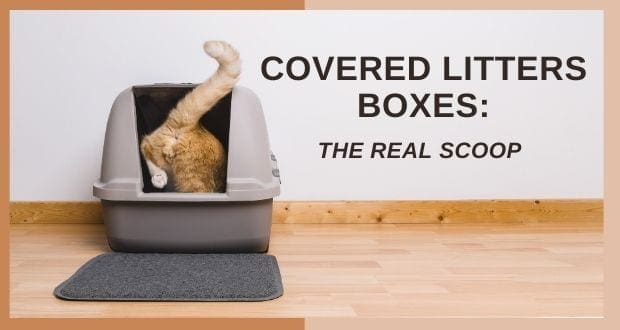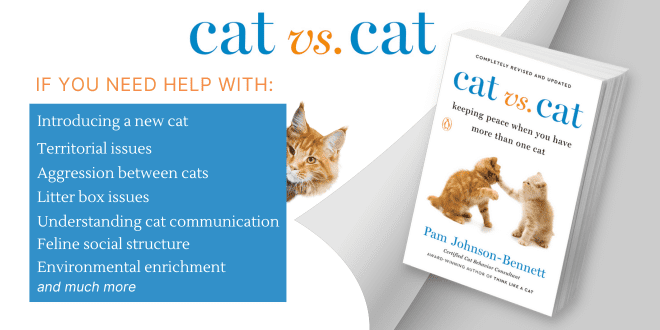
Listen to the audio version of this article
When it comes to choosing a litter box for your cat, you may think a covered one is a good choice because it offers privacy for the cat and hides all those things you don’t want to see or smell but there are some facts to consider before making that purchase. Much of the success or failure of a particular litter box has to do with the size of the box, how clean it’s kept, where it’s located, the number of boxes per cat and one other very important factor: the type of box itself. So let’s examine whether a covered box is cat-friendly or not.
From Our Perspective When it Comes to Covered Boxes
From the cat guardian’s perspective, a covered box seems ideal. It offers:
- privacy
- litter scatter control
- the ability to keep the cat’s pee and poop from being on display
- a confined way of keeping odor inside the box
If we look at it from the human’s point of view, a covered box appears, at least initially, to be a dream-come-true. It keeps everything neat and tidy inside the box and no one but the cat has to look at it. Unfortunately though, many behavior problems occur because we, as cat parents, look at a cat’s environment from our point of view and neglect to see things from the cat’s perspective.
The Cat’s Perspective of Covered Litter Boxes
If you “think like a cat” you’ll start to look at the covered litter box in an entirely different light:
- A covered box can make a larger cat feel cramped while in there
- Covered boxes don’t allow as much air circulation so it takes longer for litter to dry
- Odor is contained in the box, so it can be more offensive to the cat who is inside
- A covered box limits a cat’s visual field to see if another companion animal is approaching
- A covered box limits a cat’s escape potential and can create opportunities for being ambushed
- A covered box may not get scooped often enough
Privacy vs Safety in the Litter Box
This is, by far, my biggest issue with covered boxes. While we’re busy worrying about privacy, a cat is worried about safety. Being in the litter box puts a cat in a vulnerable position. If you have a multicat household and there’s the least bit of tension between cats, imagine how stressful it could be for one cat to go into a covered box where there’s only one way in and out. I’ve often seen situations where one cat uses the opportunity to ambush another cat in the litter box. It’s not unusual to see one cat sitting on the top of the box, ready to pounce as soon as the other cat exits the litter box. In this situation, the cat who is being ambushed will often decide to choose a much safer location for elimination. That location choice is often out in the open with more visual warning time so the cat has the chance to get away when an opponent enters the room.
There doesn’t even have to be tension in a multicat home for a cat to feel vulnerable in a covered box with no escape potential. It could just take one or two times of a cat being surprised by another cat having to use the box at the same time. It could be the family dog who sticks his nose in the box or even a toddler following the cat as he heads to the litter box. The bottom line is if a cat feels the litter box is not a safe location, his survival instinct will tell him to seek another option for elimination.
Litter Box Olfactory Assault
Another thing to think about is how a covered litter box must appear to an animal equipped with such incredible senses. Since your cat’s nose is often so close to the litter substrate itself, imagine how unpleasant it is to be in a covered box that doesn’t have enough air circulation to adequately dry the litter. The smell in the box could be overpowering enough to drive kitty away.
Cramped Accommodations When in the Litter Box
Many litter boxes, open or covered, are often too small. I recommend to my clients that they purchase large storage containers and then cut an entrance on one side for the cat to have easy access. Combine the fact that many litter boxes are too small with putting a cover on as well, and you have a cramped, unappealing litter box set-up. For many cats, the only way to use the box is to crouch down or stick their heads out the entrance.
Out of Sight… Out of Mind
I scoop my cat’s litter box at least twice a day. When I walk by the box, if I see she has eliminated, I stop and scoop. It takes just a few seconds to do daily litter box maintenance. With a covered box, however, you may not notice the cat has eliminated so you may just walk past without scooping. It also takes more time to scoop because you have to remove the top.
Covered Litter Boxes Are Inconvenient to Clean
While you may initially think a covered box will keep things neater, it actually creates more work for you. In order to scoop the box you have to remove the cover. When it comes time to thoroughly scrub the box you now have two parts of the box to clean instead of just one.
A Better Alternative to a Covered Litter Box
If you’re thinking about a covered box in order to control litter scatter, or if you have a cat who sprays in the box, choose a high-sided, open box instead. A large plastic storage container with high sides will work. All you have to do is cut out a low entrance on one side. There are also some manufacturers who make high-sided litter boxes and depending upon the size of your cat or whether he sprays in the box, one of these litter boxes may work for you. If not, a plastic storage container such as the ones made by Sterilite, is an excellent option.
Need More Information?
For more specifics on how to create the ideal litter box set-up and how to avoid litter box problems, refer to best-selling books by Pam Johnson-Bennett. Pam’s books are available at bookstores and online. We’ve included links to Amazon here on our website.
If you have a question about your cat’s behavior or health, contact your veterinarian. This article is not intended as a medical diagnosis nor is it a replacement for your cat’s regular veterinary care. This article is for general information purposes only.
 Problem Solving & Advice by Pam Johnson-Bennett Cat Behavior Expert & Best-selling Author
Problem Solving & Advice by Pam Johnson-Bennett Cat Behavior Expert & Best-selling Author




